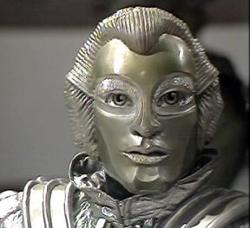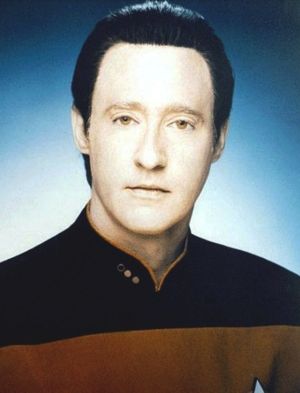As you may or may not know, I have had a long and deep-seeded fascination with zombies that started when I was just becoming a teenager. This also applies to anything human-looking but not – mannequins, robots, statues, some animated figures – ranging from wonder to aversion to actual fear. This is a pretty common thing amongst people, and has a name – the Uncanny Valley.
Why are we so afraid of things that look like us, but aren’t us? Is it innate human xenophobia? Or our evolution couldn’t equip us to deal with this concept? (I’m not counting our close primate cousins – I’m focusing on created things.) The thing is, I’ve actually traced where my own response has come from, back to my early childhood.
Have a look at this:
Looks lovely, doesn’t it? This is a Voc, a robot that appears in a Tom Baker Doctor Who story. (Okay, when I say robot, I really mean android. Carry on.) Vocs are service robots who range from mute menial robots, to normal workers, to special logistic coordinators. They look beautiful, and speak in a pleasant, smooth voice and come pre-programmed with the Laws of Robotics, which pervade so much of science fiction. Until this happens:
This image has haunted my dreams from the first time I saw it at the age of about 4, to even this day. I even had a bit of a shudder whilst searching for the picture! These creatures, in cardboard shoes and costumes made from shower curtains, stumbling through the hallways, strong machine hands covered in spray-painted washing-up gloves with chunky fake blood, their distorted, broken voices just repeating one word over again – ‘Kill.’
Still on Doctor Who, you have the big robotic kahuna – Cybermen. Originally from a dying twin of Earth, Mondas, forced to convert their feeble human bodies into metal ones, replacing limbs and eventually integrating organic matter into metallic bodies. Cyborgs, which many people would admit is the ultimate nightmare of human and robotic co-existence. Cybermen later end up wanting to convert humans to make more Cybermen – slicing their heads open and removing their brains and central nervous system to implant into a metal shell. Or even better, to build around their existing bodies, like the Mondasians in the beginning. Some would argue that cyborgs are the future of humanity, and you have to admit that some medical advancements are heading in that direction – robotic prosthetics, artificial valves and speech units. But let’s not think about that, shall we?
That’s the fear part taken care of. What about the fascination and wonder?
Enter this very special robot:
I could go on about Data forever and how awesome he is, but I’ll try to keep it brief. I fell in love with him as a child of 5, and then continued as a teenager, then an adult. I came to understand his complexity, and how his pursuit of humanity was supposed to reflect our own. I learned about Asimov’s theory of the positronic brain with neural nets and how much that science was used to explain Data’s backstory and how the actual practices of robotics and cybernetics was born out of it (not to mention how well-written Data generally is and how fabulously he is acted).
Why are we so obsessed with the idea of creating an inorganic copy of ourselves, especially with trying to create an artificial intelligence that is identical to our own? Is it that we use the idea of Data – to have a human-but-not foil to reflect upon our own humanity? Would creating a positronic brain finally help us understand how our own works? Or is it an extension of the human instinct to procreate? Is it a desire to ‘advance’ human achievement? I’m sure there are some sci-fi authors who can help me answer that.
Going back to Data – it’s funny how much we tend to anthropomorphise things. It’s even mentioned in an episode of TNG. We’re scared of humanoid things that aren’t actually human, but yet we secretly want them to be like us at the same time. It’s said that humans have a real knack for pattern recognition and the first pattern we are trained to recognise is a face. This makes sense when people sell a grilled cheese on eBay for $50,000 because you can see the Virgin Mary if you look hard enough.
I must admit I am especially guilty of this trait – I have assigned a name and gender to my computer. I consider my cat to be my child. But you could probably say the same thing about people who trawl the internet for hours looking for new LOLcats, and people who proudly post pictures on Facebook of the birth of their new car, with name. We’ve been doing this for centuries – projecting human qualities and personalities on animals, places, vehicles and inanimate objects, just like we still refer to countries, cars, planes and ships as being female.
So, what about the zombies?
That really came about because of this:
I first played Resident Evil when I was twelve. I loved the dystopian idea of a wrecked human species. (I loved zombies before they were cool, dammit!) It’s funny how drawn people are to dystopian ideas, even though we would never want to see it happen. It’s all about opposites.
I may have said this before, but I love the idea of zombies because they are the flipside of humanity. I generally try to think proudly of my fellow humans, and revel in their achievements and ingenuity. Zombies strip all of that away from us, although some may argue that zombies walk around among us now, just in another form.
Zombies take away all of our special attributes and reduce us down to our most basic forms – shells, unfeeling, unaware, unintelligent with only the desire to feed. The fact that they are biologically dead is an added bonus – we find death and the processes thereof such an abhorrent and fearful thing, so the ante is already upped. The allegory is powerful – we are watching ourselves literally crumble before our very eyes. Our cities, our cultures, our power, our fight to the evolutionary summit is wasted.
And there’s also the contention of their creation, depending on which origin story you prefer. There’s no better story than a created virus which was supposed to repair life, but utterly destroys it instead (Resident Evil-style). I also think it’s scarier if animals can be infected as well – our only allies turning against us.
I think it’s funny how astute creators have been in picking up our natural aversion to humanoid things, even before the Uncanny Valley concept had been created – the many variations of robots and cyborgs, shop window dummies coming to life and killing people, dolls doing the same, zombie hordes, the Statue of Liberty going for a wee stroll around Manhattan. It seems like this fear is so ingrained, and sometimes it’s heavily exacerbated by books/TV/movies, even inadvertently – look at early 3D animation like The Polar Express and Final Fantasy and don’t tell me you’re not creeped out by those mask-like faces and the dead, dead eyes.
So, are you unsettled by Robocop or the Terminator? Do you avert your eyes from mannequins in department stores (or secretly hope they turn into Kim Cattrall)? Do you plan your emergency contingency according to The Zombie Survival Guide? Can you escape from the Uncanny Valley?




